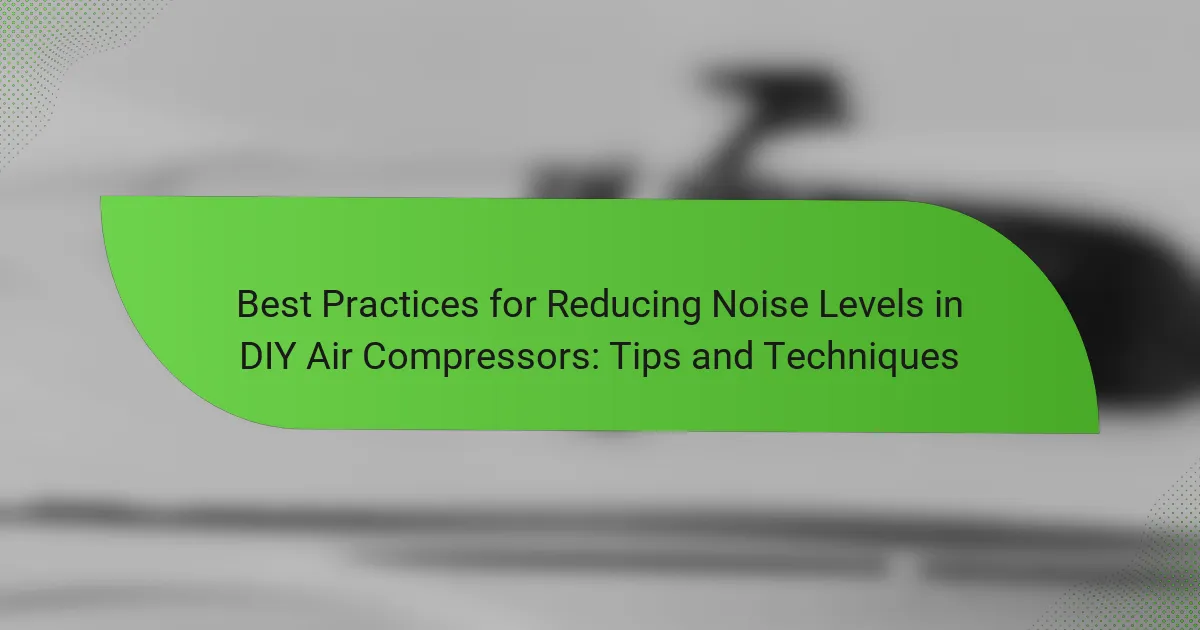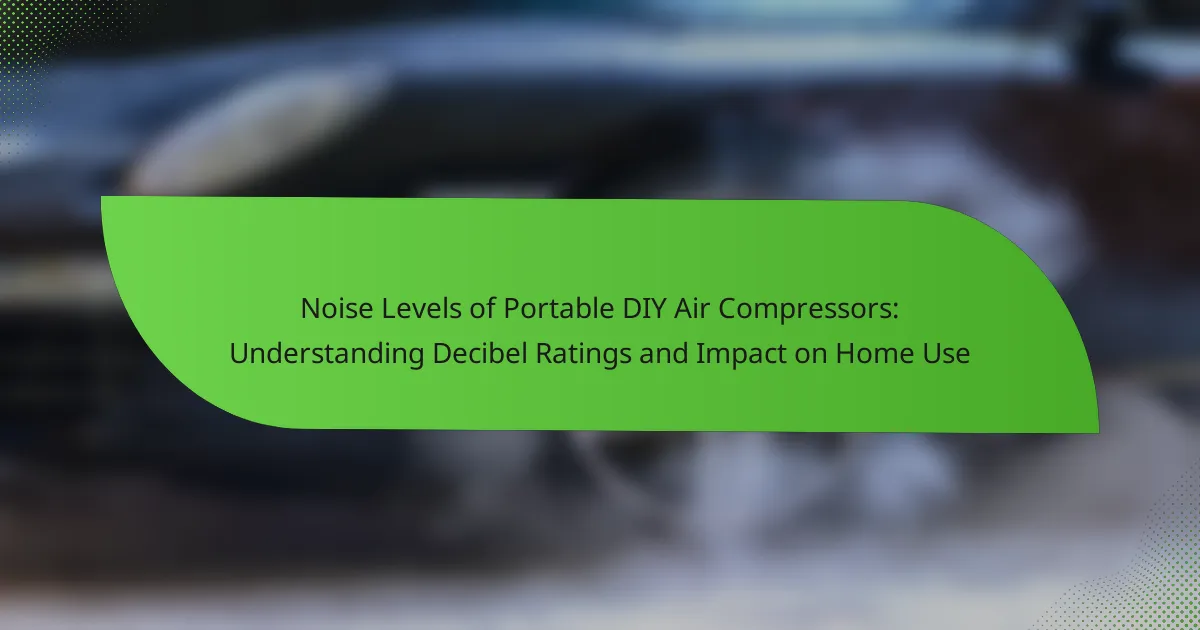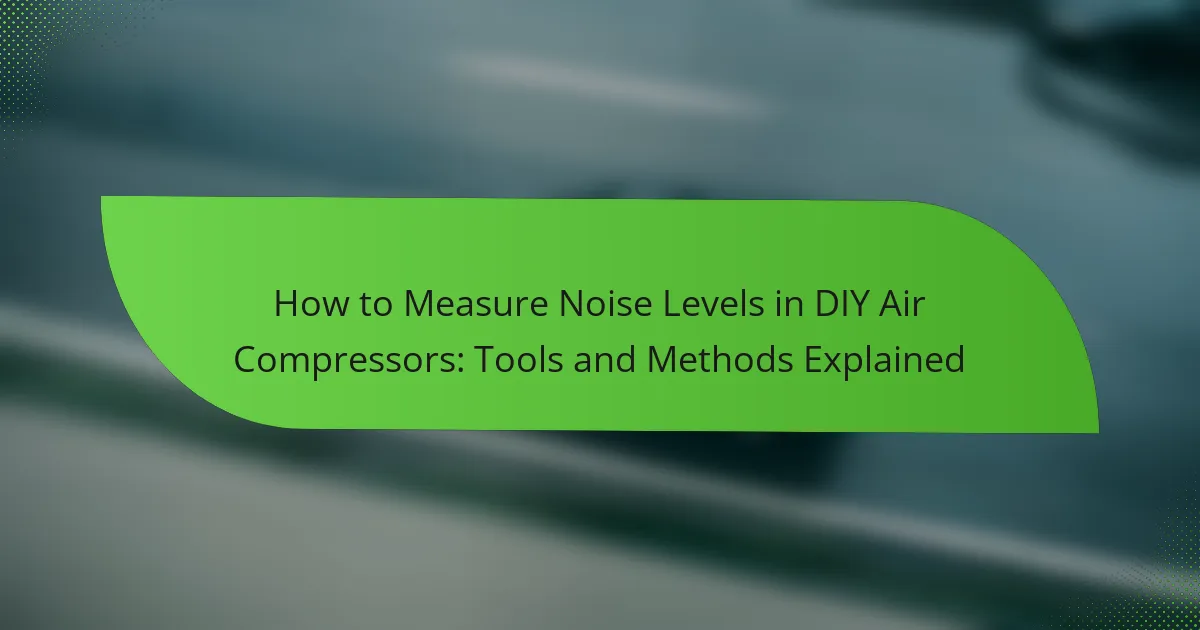Noise levels in DIY air compressors vary significantly, typically ranging from 60 to 100 decibels based on the size and design of the unit. Smaller, portable compressors generally operate at quieter levels of 60-70 decibels, while larger industrial models can reach up to 90-100 decibels. Prolonged exposure to noise levels exceeding 85 decibels poses a risk of hearing damage, making it essential for users to understand these levels when selecting a compressor for home use. Compliance with regulations such as the Occupational Safety and Health Administration (OSHA) standards, local noise ordinances, and the American National Standards Institute (ANSI) guidelines is crucial for ensuring safe operation and minimizing noise pollution. Additionally, adherence to the ISO 3744 standard for measuring sound power levels helps accurately assess noise emissions from compressors.

What are the noise levels associated with DIY air compressors?
DIY air compressors typically produce noise levels ranging from 60 to 100 decibels. The exact noise level depends on the compressor’s size and design. Smaller, portable models tend to be quieter, often around 60-70 decibels. Larger, industrial-grade compressors may reach up to 90-100 decibels. Prolonged exposure to noise levels above 85 decibels can lead to hearing damage. According to the CDC, consistent exposure to high noise levels can affect hearing health. Understanding these noise levels is crucial for selecting the right compressor for home use.
How are noise levels measured in air compressors?
Noise levels in air compressors are measured using a sound level meter. This device quantifies sound intensity in decibels (dB). Measurements are typically taken at a specified distance from the compressor, often one meter. The testing environment should be free from reflective surfaces to ensure accuracy. Standardized testing procedures, such as those outlined by ISO 3744, may be followed. These procedures help to ensure consistent and comparable results across different models. Additionally, manufacturers often provide noise ratings in their product specifications. This information helps consumers make informed decisions regarding noise levels.
What units are used to quantify noise levels?
Noise levels are quantified using decibels (dB). The decibel scale measures sound intensity logarithmically. This means that an increase of 10 dB represents a tenfold increase in sound intensity. For example, normal conversation is around 60 dB, while a lawn mower can reach 90 dB. The scale is used to assess potential hearing damage and environmental noise. Regulatory standards often specify maximum permissible noise levels in dB for various equipment. These standards help protect both human health and the environment.
How does distance from the compressor affect noise level perception?
Distance from the compressor significantly affects noise level perception. As distance increases, the intensity of sound decreases due to the inverse square law. This law states that sound intensity diminishes by approximately 6 dB for every doubling of distance. Noise perception also depends on environmental factors like absorption and reflection. For example, soft surfaces absorb sound, reducing perceived noise levels. Conversely, hard surfaces can reflect sound, increasing noise perception. Thus, maintaining a greater distance from the compressor can lead to a quieter experience for users.
Why is it important to consider noise levels in DIY air compressors?
Considering noise levels in DIY air compressors is crucial for compliance with regulations and user comfort. Many regions have noise ordinances that restrict sound levels in residential areas. Excessive noise can lead to complaints from neighbors and potential fines. Additionally, high noise levels can cause hearing damage over prolonged exposure. Research indicates that sounds above 85 decibels can be harmful. Therefore, selecting quieter models can enhance the user experience. It also promotes a safer working environment. Overall, noise levels impact both legal compliance and health considerations.
What impact do high noise levels have on health and safety?
High noise levels can significantly impact health and safety. Prolonged exposure to noise above 85 decibels can lead to hearing loss. This condition is known as noise-induced hearing loss (NIHL). Additionally, high noise levels can cause stress and anxiety. Elevated stress levels can result in cardiovascular issues. Studies show that noise pollution is linked to increased blood pressure. Furthermore, excessive noise can impair cognitive function and concentration. This impairment can lead to accidents and injuries in work environments. Therefore, managing noise levels is crucial for maintaining health and safety.
How can noise levels affect the surrounding environment?
Noise levels can significantly affect the surrounding environment. High noise levels can lead to stress in wildlife, disrupting their natural behaviors. For example, studies show that increased noise can cause birds to change their nesting habits. Additionally, elevated noise can impact human health by increasing stress levels and causing sleep disturbances. According to the World Health Organization, prolonged exposure to noise above 65 decibels can lead to adverse health effects. Urban areas often experience noise pollution, which can degrade quality of life. Therefore, managing noise levels is crucial for environmental and public health.
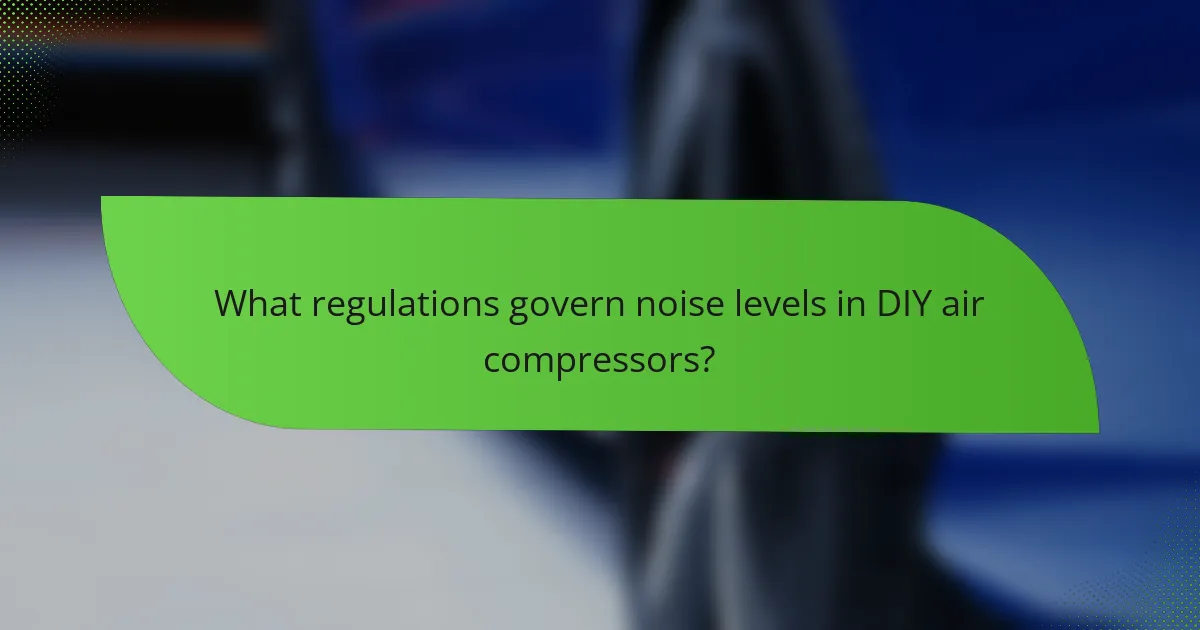
What regulations govern noise levels in DIY air compressors?
Regulations governing noise levels in DIY air compressors primarily include the Occupational Safety and Health Administration (OSHA) standards and local noise ordinances. OSHA sets permissible noise exposure limits to protect workers from hearing loss, typically at 90 decibels for an 8-hour workday. Local noise ordinances may vary by municipality and often impose restrictions on noise levels during specific hours. The American National Standards Institute (ANSI) also provides guidelines for measuring and controlling noise levels in equipment. Compliance with these regulations ensures safe operating conditions and minimizes disturbances to surrounding areas.
What are the key regulations to be aware of?
Key regulations regarding noise levels in DIY air compressors include the Occupational Safety and Health Administration (OSHA) standards. These standards set permissible noise exposure limits to protect workers from hearing loss. For general industry, the permissible noise level is 90 dBA over an 8-hour workday. Additionally, the Environmental Protection Agency (EPA) has guidelines for noise control, which recommend keeping noise levels below 55 dBA in residential areas. Local noise ordinances may also impose stricter limits. Compliance with these regulations is crucial to avoid penalties and ensure safety.
How do local noise ordinances affect DIY air compressor usage?
Local noise ordinances significantly affect DIY air compressor usage by imposing restrictions on permissible noise levels. These regulations vary by location, often defining specific decibel limits during certain hours. For instance, many municipalities enforce lower noise limits during nighttime to reduce disturbances. Violating these ordinances can lead to fines or complaints from neighbors. Additionally, some areas may require permits for equipment that exceeds noise thresholds. Therefore, individuals using air compressors should check local regulations to ensure compliance. This adherence helps avoid legal issues and promotes community harmony.
What federal standards apply to air compressor noise levels?
The federal standards that apply to air compressor noise levels are primarily regulated by the Occupational Safety and Health Administration (OSHA). OSHA sets permissible noise exposure limits to protect workers from hearing loss. The general permissible noise exposure limit is 90 decibels (dBA) for an 8-hour workday. Additionally, the Environmental Protection Agency (EPA) provides guidelines for noise control, although it does not set specific limits for air compressors. These standards aim to minimize noise pollution and ensure safe working conditions. Compliance with these regulations is essential for manufacturers and users of air compressors to promote workplace safety.
How can compliance with noise regulations be achieved?
Compliance with noise regulations can be achieved through effective sound management practices. Implementing soundproofing materials can significantly reduce noise levels. Regular maintenance of equipment ensures optimal performance and minimizes excessive noise. Utilizing quieter machinery or tools designed for low noise output is essential. Establishing operational limits on noise-producing activities can help in compliance. Training employees on noise reduction techniques can further enhance compliance efforts. Monitoring noise levels with appropriate measuring devices provides data for adjustments. Adhering to local noise ordinances and guidelines is crucial for legal compliance.
What modifications can be made to reduce noise levels?
To reduce noise levels in DIY air compressors, several modifications can be implemented. Installing soundproof enclosures can significantly dampen noise. Adding vibration isolation pads minimizes vibrations that contribute to noise. Using quieter models or components, such as low-noise motors, can also help. Implementing acoustic panels around the compressor area absorbs sound waves. Regular maintenance, including lubricating moving parts, reduces operational noise. Lastly, ensuring proper mounting and securing of the compressor reduces rattling and vibrations. These modifications collectively enhance noise reduction effectiveness.
How can users test their DIY air compressors for compliance?
Users can test their DIY air compressors for compliance with noise regulations by measuring sound levels with a decibel meter. First, they should place the decibel meter at a specified distance from the compressor, typically 3 to 5 feet. Next, they need to operate the compressor under normal conditions. The meter will provide a reading of the noise level in decibels. Compliance standards often require noise levels to be below a certain threshold, such as 70 dB for residential areas. Users should compare their readings against local regulations or standards set by organizations like the Occupational Safety and Health Administration (OSHA). This process ensures that the DIY air compressor meets safety and noise regulations.
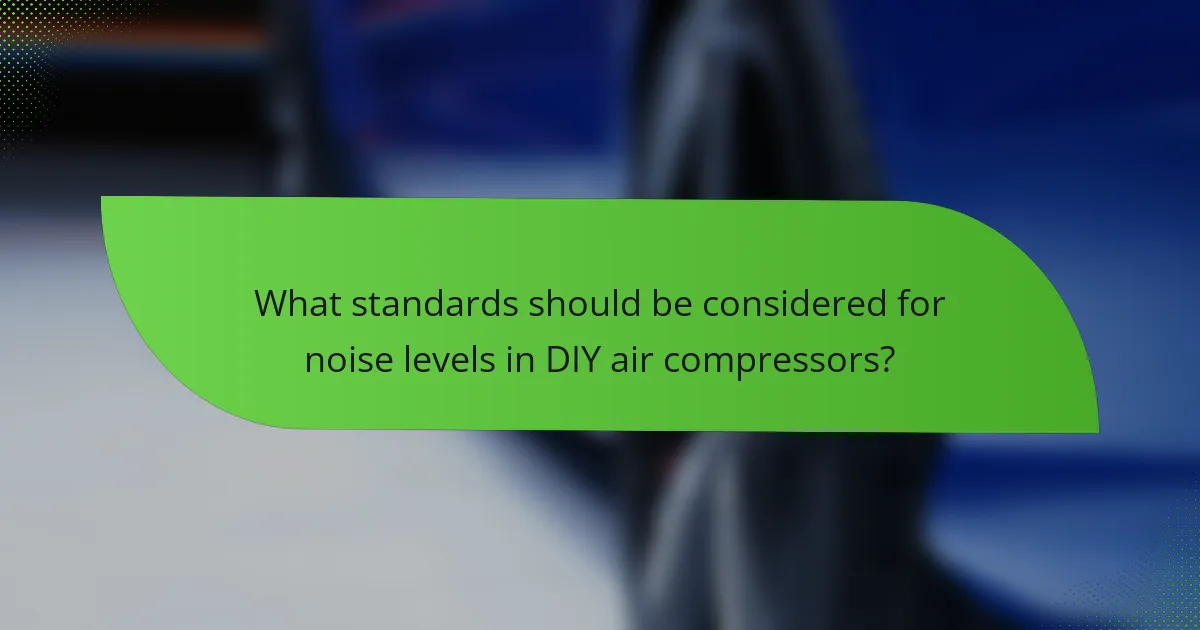
What standards should be considered for noise levels in DIY air compressors?
Noise levels in DIY air compressors should comply with the ISO 3744 standard. This standard outlines procedures for measuring sound power levels in various environments. It ensures that noise emissions are assessed accurately. Additionally, the OSHA regulations recommend a maximum exposure limit of 90 dBA over an 8-hour workday. Many manufacturers also adhere to the ANSI/ISO 12100 standard for safety and noise reduction. These standards help mitigate noise pollution and protect user health. Compliance with these regulations is crucial for safe and efficient operation.
What industry standards exist for air compressor noise levels?
The primary industry standard for air compressor noise levels is ANSI/ISO 3744. This standard outlines the methods for determining the sound power levels of noise sources. It is widely recognized in the construction and manufacturing sectors. Another relevant standard is ISO 11203, which specifies procedures for measuring sound power levels in various environments. The European standard EN 15012 also provides guidelines for measuring noise levels of portable air compressors. Compliance with these standards ensures that manufacturers produce quieter equipment. Additionally, OSHA regulations may apply in workplace settings to limit noise exposure. These standards aim to protect workers and the public from excessive noise pollution.
How do these standards vary by compressor type?
Standards for noise levels in air compressors vary significantly by compressor type. Reciprocating compressors typically have higher noise standards due to their mechanical operation. These compressors can produce noise levels ranging from 70 to 90 decibels. Rotary screw compressors, on the other hand, often operate at lower noise levels, usually between 60 and 75 decibels.
Standards for portable compressors may be less stringent, allowing for higher noise outputs. In contrast, industrial compressors are subject to stricter regulations, often requiring noise reduction measures. The American National Standards Institute (ANSI) and the International Organization for Standardization (ISO) provide guidelines that vary based on compressor design and application. These standards ensure that manufacturers design compressors to meet specific noise level requirements based on their intended use.
What role do certification marks play in assessing noise levels?
Certification marks indicate compliance with specific noise level standards. These marks assure consumers that products meet regulatory requirements for noise emissions. They help in objectively assessing and comparing noise levels of different products. Certification bodies perform rigorous testing to verify that products adhere to established noise guidelines. For example, the American National Standards Institute (ANSI) sets standards for noise measurement. Products with certification marks can be trusted to operate within acceptable noise limits. This reduces the risk of noise pollution and enhances user safety. Ultimately, certification marks serve as a reliable indicator of noise performance in consumer products.
How can users ensure their DIY air compressors meet these standards?
Users can ensure their DIY air compressors meet noise level standards by selecting appropriate components. They should use quieter motors designed for low noise operation. Additionally, soundproofing materials can be applied to the compressor housing. Users must also follow local noise regulations during construction. Testing the compressor’s noise output with a decibel meter is essential. Operating the compressor during designated hours can further comply with regulations. Regular maintenance ensures optimal performance and adherence to standards. Understanding specific local regulations helps users stay compliant.
What best practices should be followed during installation and use?
During installation and use of DIY air compressors, follow safety and operational best practices. Ensure the compressor is placed on a stable, level surface. This prevents tipping and enhances performance. Use proper ventilation to avoid overheating. Adequate airflow extends the compressor’s lifespan. Always refer to the manufacturer’s guidelines for installation specifics. This ensures compliance with safety standards. Check for leaks in hoses and fittings regularly. Leaks can reduce efficiency and increase noise levels. Utilize hearing protection if noise levels exceed 85 decibels. This is crucial for long-term hearing health. Maintain the compressor by regularly checking oil levels and filters. Proper maintenance minimizes noise and enhances functionality.
How can regular maintenance help in maintaining acceptable noise levels?
Regular maintenance helps in maintaining acceptable noise levels by ensuring that all components of the air compressor are functioning optimally. Well-maintained equipment operates more efficiently, reducing unnecessary vibrations and noise. Regular checks can identify worn-out parts that may contribute to increased noise. For instance, lubricating moving parts minimizes friction, which can lead to quieter operation. Additionally, maintaining air filters prevents blockages that can cause the compressor to work harder, resulting in higher noise levels. Studies show that properly maintained compressors can operate at noise levels significantly below regulatory limits, ensuring compliance with standards.
What tips can help minimize noise levels in DIY air compressors?
To minimize noise levels in DIY air compressors, consider using soundproofing materials. Enclosing the compressor in a soundproof box can significantly reduce noise. Use vibration-dampening pads to absorb vibrations from the compressor. Additionally, installing a muffler can help decrease exhaust noise. Regular maintenance ensures that the compressor operates efficiently and quietly. Opt for quieter compressor models that are designed to produce less noise. Finally, place the compressor on a stable surface to minimize noise from vibrations. These methods have been shown to effectively reduce noise levels in various applications.
What are the most effective soundproofing techniques for air compressors?
The most effective soundproofing techniques for air compressors include using soundproof enclosures, acoustic panels, and vibration isolation mounts. Soundproof enclosures can significantly reduce noise levels by enclosing the compressor in a sound-dampening box. Acoustic panels absorb sound waves and can be installed on walls surrounding the compressor to minimize noise reflection. Vibration isolation mounts reduce the transmission of vibrations from the compressor to the floor, which helps lower noise levels. Additionally, using rubber mats can further dampen vibrations. According to the National Institute for Occupational Safety and Health (NIOSH), implementing these techniques can reduce noise exposure significantly, improving working conditions.
How can users select quieter compressor models for their projects?
Users can select quieter compressor models by examining their decibel (dB) ratings. A lower dB rating indicates a quieter operation. Many manufacturers provide dB ratings in product specifications. Users should look for models with ratings below 70 dB for reduced noise. Additionally, users can consider compressors with sound-dampening features. These features may include insulated enclosures or quieter motor designs. Research shows that compressors with a dB rating of 60 or lower are often suitable for indoor use. Selecting the right compressor based on these criteria can significantly minimize noise in projects.
The main entity of this article is DIY air compressors, specifically focusing on their associated noise levels and the relevant regulations and standards. The article provides a detailed examination of the noise levels produced by various types of compressors, ranging from 60 to 100 decibels, and the importance of understanding these levels for health and safety compliance. It outlines measurement methods, the impact of distance on noise perception, and the significance of adhering to local noise ordinances and OSHA standards. Additionally, the article discusses best practices for selecting quieter models, implementing soundproofing techniques, and maintaining compliance with noise regulations to ensure a safe working environment.
